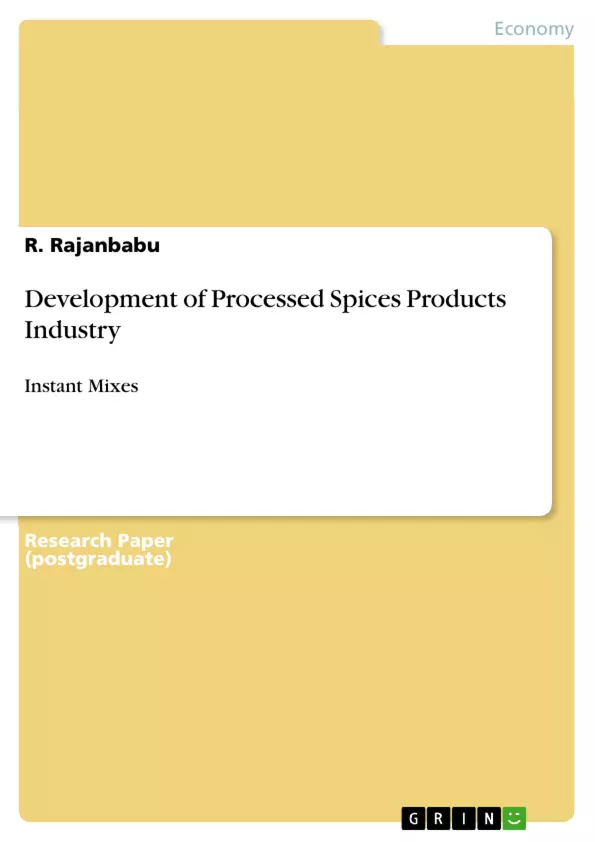Quick food styles are catching up fast because of a larger number of working couples, domestic fuel crisis, non-availability of reliable domestic servants and breaking-up of joint family system. Neither time nor patience to prepare the ingredients and wholesome food in the house itself, the high price of ingredients and ready-mix are also a significant factor responsible for the spectacular increase in the demand for processed spices products. The processed spices products industry could increase the value of production considerably through the introduction of new variants and hence diversification has also a direct bearing on the product growth.
Inhaltsverzeichnis (Table of Contents)
- Introduction
- Introduction
- History of Indian Spices
- Indian Spices
- Spices Trade
- Producing Countries of Selected Spices
- Region-wise Export of Indian Spices
- Import
- Profile of the Processed Spices
- Need for the Study
- Problem Formulation
- Questions rose
- Objectives of the Study
- Hypotheses
- Methodology
- Scope
- Data Collection
- Data Analysis
- Review of Literature
- Profile of the Study Area and Processed Spices Products Firms
- Diversification Patterns
- Introduction
- Empirical Studies
- Classification
- Pure Spice Powders
- Point of Divergence
- Diversification Pattern and Time-lag in Pure Spice Powders
- Masala Powders
- Diversification Pattern and Time-lag in Masala Powders
- Cooking Pastes
- Diversification Pattern and Time-lag in Cooking Pastes
- Instant Mixes
- Diversification Pattern and Time-lag in Instant Mixes
- Conclusion
- Growth Performance of Processed Spices Products Industry
- Introduction
- The Need for Growth
- Empirical Studies
- Model
- Growth Indicators
- Number of Enterprises
- Gross Block
- Employment
- Output
- Comparative Analysis of Inter-Product Group Growth Rates
- Conclusion
- Total Factor Productivity Trends of Processed Spices Products Industry
- Introduction
- Significance of Productivity Measurement
- Total Factor Productivity
- Measurement of Total Factor Productivity
- Solow Index
- Total Factor Productivity in Processed Spices Products Industry
- Inter-Product Group Comparative Analysis
- Conclusion
- Summary and Conclusion
- Introduction
- Diversification Patterns
- Growth Performance of Processed Spices Products Industry
- Total Factor Productivity Trends of Processed Spices Products Industry
- Conclusion
- Suggestions and Recommendations
- Area for further Research
Zielsetzung und Themenschwerpunkte (Objectives and Key Themes)
This study aims to analyze the growth performance and total factor productivity trends of the processed spices products industry in Tiruchirappalli District, Tamil Nadu, India. The study focuses on the diversification patterns within the industry, examining the growth of different product groups such as pure spice powders, masala powders, cooking pastes, and instant mixes.- Diversification patterns and time-lag within different product groups in the processed spices industry.
- Growth performance of the processed spices products industry, analyzing indicators such as number of enterprises, gross block, employment, and output.
- Total factor productivity trends of the processed spices products industry using the Solow index.
- Comparative analysis of growth rates and total factor productivity across different product groups within the industry.
- Recommendations for future development and research within the processed spices products industry.
Zusammenfassung der Kapitel (Chapter Summaries)
- Introduction: This chapter provides an overview of the global spices market, highlighting India's role as a major spice producer and exporter. It also details the historical significance of spices in India and discusses the growing demand for natural flavors in the food industry.
- Diversification Patterns: This chapter analyzes the diversification patterns of the processed spices products industry, focusing on the different product groups: pure spice powders, masala powders, cooking pastes, and instant mixes. It examines the time-lag and trends in diversification within each product group.
- Growth Performance of Processed Spices Products Industry: This chapter investigates the growth performance of the industry, using various indicators such as number of enterprises, gross block, employment, and output. It analyzes the growth rates of different product groups within the industry.
- Total Factor Productivity Trends of Processed Spices Products Industry: This chapter examines the total factor productivity (TFP) trends of the industry. It explains the importance of productivity measurement and uses the Solow index to assess the TFP of the processed spices products industry. This chapter also analyzes the TFP across different product groups within the industry.
Schlüsselwörter (Keywords)
This study explores the processed spices products industry in India, focusing on the key themes of diversification, growth performance, and total factor productivity. It analyzes different product groups, including pure spice powders, masala powders, cooking pastes, and instant mixes, using empirical data and economic models. The study employs the Solow index to measure total factor productivity, providing insights into the industry's efficiency and potential for growth. Keywords associated with the study include processed spices, diversification patterns, growth performance, total factor productivity, Solow index, pure spice powders, masala powders, cooking pastes, instant mixes, and the Indian spice industry.
Ende der Leseprobe aus 69 Seiten
- nach oben
- Arbeit zitieren
- Dr. R. Rajanbabu (Autor:in), 2014, Development of Processed Spices Products Industry, München, GRIN Verlag, https://www.grin.com/document/310463
Blick ins Buch



